Touring The Massive Regions Of Shadow Of War
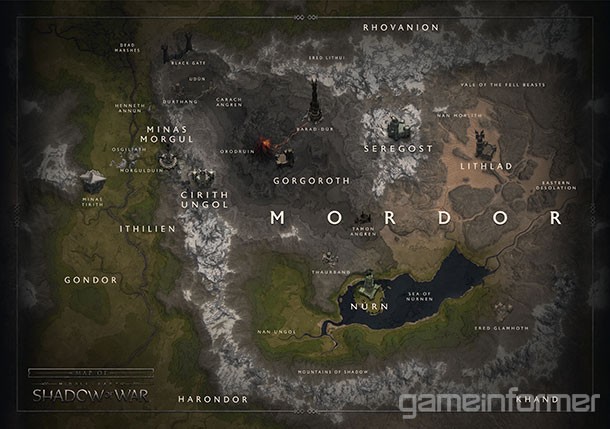
Middle-earth: Shadow of Mordor allowed players to explore Sauron's forbidding home in ways never before showcased in a video game. However, with only two regions available to play in, players only got a taste of the geographic diversity available in Middle-earth's most notorious area.
With Middle-earth: Shadow of War, Monolith is expanding from two regions to five new locales, making for much more variance to the backdrop of Talion's sophomore quest. Not only that, but according to vice president of creative Mike de Plater, fans should expect much more from each of the five regions.
"Every region is significantly bigger than either of the regions we had in the first game, and also much more diverse," he says. "We have a lot more verticality and a lot more detail in the environment and topography. We have caves and mountains and pits and those sorts of things. We have the fortresses. Each of the regions is controlled by these large fortresses. Then we have that each of the regions can vary based on the tribe that's in control of it."
De Plater says that the sheer diversity of the world is the most important upgrade the open world of Shadow of War features over its predecessor. "The fact that between the different environments, we have forests in Núrn and huge fields of ice and ice caves in Seregost, and the lava [of Gorgoroth]... there's just so much more variety between the different environments because we were really able from the beginning to take advantage of being next-gen," he says. "There's so much more detail in the navigation and the environments and the world and the vegetation. The opportunities are in there for gameplay in terms of combat, stealth, ranged, navigation, big battles... but from an environmental and world and gameplay point-of-view, it's advanced so much. There is that meaningful sense of variety, so when you're going from place-to-place it really feels varied and different."
We took a tour of the five regions with the team. You can learn all about the explorable areas of Shadow of War below.
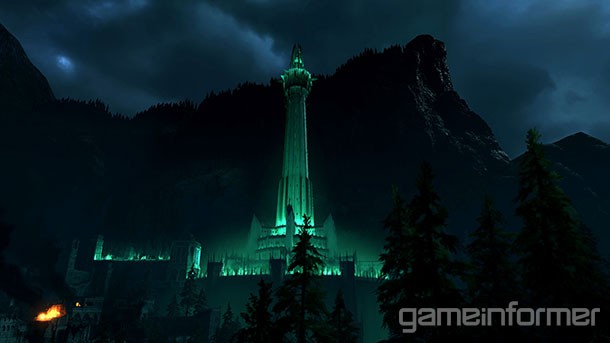
Minas Ithil/Minas
Morgul
One of the most important regions to the story is Minas Ithil/Minas
Morgul. This large city of Gondor gives players a more civilized setting to
explore, as well as a lot of verticality and fun traversal elements thanks to
its more urban and developed setting, with several structures lined up in a row.
"We wanted to visualize this city of Minas Ithil and we wanted to recreate
these concepts that people know and love from the stories and the films,"
director of art Phil Straub says. "Minas Tirith was built in such a way that it
had multiple defensive levels associated with it, and we decided for Minas Ithil
to have that same concept. There's actually some wilderness around there too.
I'd say about a fourth of the level is wilderness that's the exterior part
outside of the main level. There's some cool story and narrative things that
that happen over there."
Over the course of the game, you get to see this region transform into Minas Morgul as the Witch-king of Angmar takes it under his control. The transformation signals a big turning-point for the story. From an environmental standpoint, the color palette changes from the vibrant Gondorian hues to the sickly green and black ink typically associated with the . "Obviously, the gameplay completely changes; it's completely different from the beginning of the game to when it turns into Minis Morgul," Straub says. "There's lots of cool gameplay opportunities. Of course, the Witch-king is controlling it, so you have the Nazgûl and all of the cool visuals and different combat opportunities that they bring."
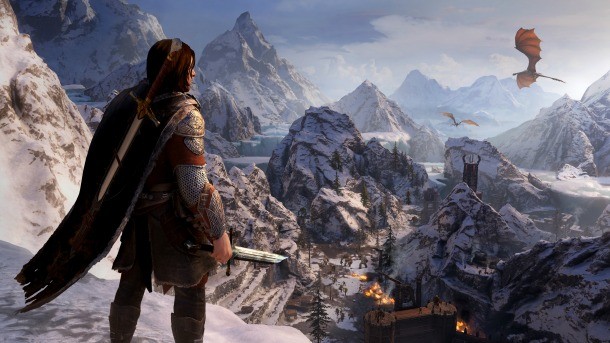
Seregost
Seregost is a snowy region high in the mountaintops that
brings not only a new type of weather, but also a lot of verticality and
elevation changes not seen in Shadow of Mordor. "For this game, I really wanted
to push elevation," says Straub. "I think we were fairly flat in the last game,
and there was a number of reasons for that but I wanted to have more of an
elevation variety. And of course, we think about weather, so we wanted to make
sure we had a place where it could snow and we also were looking for geological
variety."
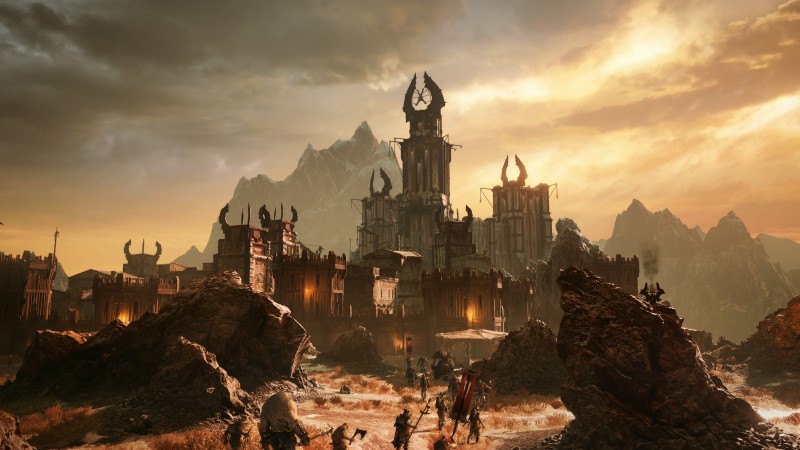
Cirith Ungol
The orc stronghold makes an appearance in Shadow of War,
giving players beautiful vistas and an awesome layer of cloud coverage beneath
the fortress on the ledge. Outside of the fortress in the clouds, players can
explore a series of caves unlike anything seen in Shadow of Mordor. "That was
another thing that we hadn't done before and we really wanted to expand on that
type of geology and sell the idea of ancient civilizations that had inhabited
that, and now it is sort of the frontlines of Sauron's forces," Straub says.
"That's where they're really getting ready for war and that's where the engines
of war are fueling Minas Ithil. This is a massive cave the size of a level.
It's freaking huge. And we have water features in there and Shelob is around
there too, so that's a nice touchpoint to the lore."
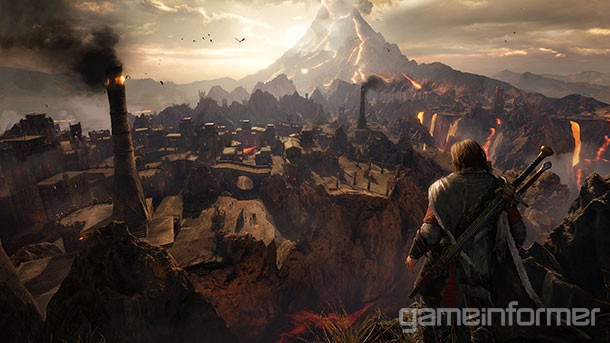
Gorgoroth
Gorgoroth is perhaps the landscape you most closely
associate with Mordor. According to Straub, that very fact made its inclusion
in Shadow of War all the more important. "I felt like we really, really needed
to have that signature Mordor level that we just didn't have in Shadow of
Mordor," he says. "It's sort of the culmination of all of these iconic
locations and structures that everybody knows and loves from the lore made
real. Nobody's played in this hellscape that people think of associated with
Sauron and Mordor in this generation or last generation of consoles, so it was
an opportunity to make this place come to life."
The team takes full advantage of the opportunities afforded by Gorgoroth by concentrating on the industrialization of the orcs. "That's a thing that we've paid off a lot more in this game than in the last game," Straub says. "That was another big thing that I wanted to see. I wanted to see this engine of war, I wanted to see smokestacks. I want this place to feel like it's feeding this massive army that's trying to take over Middle-earth."
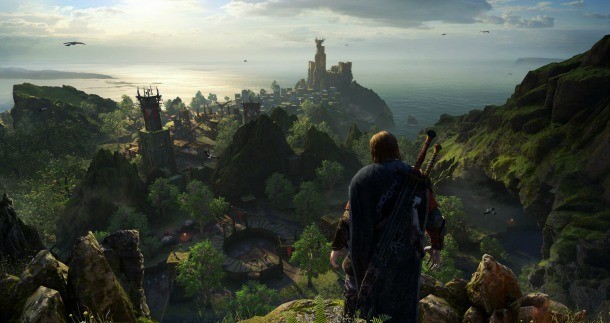
Núrn
Núrn is the one region from Shadow of Mordor that reappears
in Shadow of War. Don't expect to see the same locales this time around,
however. The area of Núrn you explore in this game is an island in the sea, so
it allows the team to present a completely different region than the other
areas you explore. "It's isolated, so it's by itself in the Sea of Núrn and all
the cool things that come with that, so you have waterfalls and all that,"
Straub says. "Another story that we're trying to tell with that is a Tolkien
theme is the destruction of nature, so if you go through that level, you'll
notice that there's a lot of deforestation that's happening. The orcs are
working hard to feed that war machine; they're cutting down trees, there are
brushfires throughout the region."
This version of Núrn combines several different biomes, which Straub thinks will help this version stand apart from its Shadow of Mordor predecessor. "A good third of the level is heavily forested and has got all of these twisted, creepy trees and swamplands and there's lot of scary things that happen in that forest," he says. "The culmination of that forest being the tree that represents [Carnán]. She's this nature spirit and she can take many forms. She inhabits the underlying root area of the tree."
During my time at Monolith, I was able to see for myself how diverse these environments are. Even though I didn't have unlimited time to poke around, each area feels distinct from the rest of the regions, as well as massive. I'm looking forward to exploring these areas further when Middle-earth: Shadow of War launches on October 10.
Click on the banner below to enter our constantly updating hub of exclusive content.

Get the Game Informer Print Edition!
Explore your favorite games in premium print format, delivered to your door.
- 10 issues per year
- Only $4.80 per issue
- Full digital magazine archive access
- Since 1991










